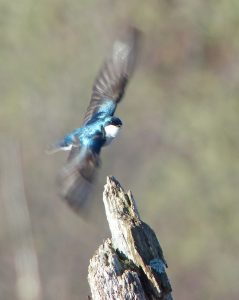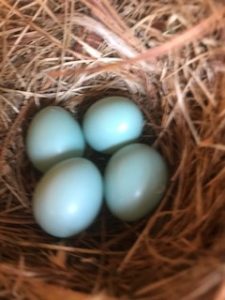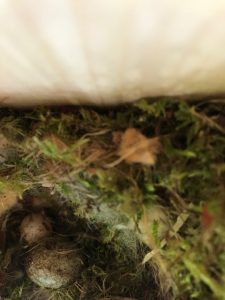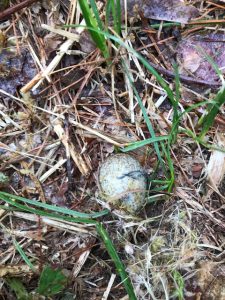In mid-August, LLCT wrapped up a successful season of nest box monitoring. Nest boxes provide important shelter for cavity nesting birds, and LLCT’s program particularly focuses on supporting Eastern Bluebirds and Tree Swallows. By narrowing our focus to these two species of birds, we can build suitable nest boxes and locate the boxes in appropriate habitat.
Thanks to the dedication of Patti Cable, our volunteer box monitor, we have great data about this year’s fledglings! Patti monitored ten boxes (located in Chapman Pasture and two other fields in Lincoln) three times a week from March until mid-August. As part of her monitoring, Patti visited each box to determine what kind of bird was nesting there, how many eggs and/or chicks there were, and the approximate timeline for fledging.
In total, Patti documented twelve Eastern Bluebird and seven Tree Swallow fledglings.
The first Eastern Bluebird egg appeared on April 10th and hatched on May 3rd, with the chicks fledging around May 25th. Tree Swallows arrive in Lincoln later, so the last Tree Swallow egg was laid on June 10th, hatched on June 26th, and the chicks fledged around July 18th. One particular “star” nest box hosted both a Bluebird and a Tree Swallow nest, as Patti cleaned out the box as soon as the Bluebird chicks had fledged, and the Tree Swallows immediately moved in!
Part of Patti’s work also involves managing House Sparrows that nest in the boxes. House Sparrows are non-native, cavity nesting birds. They aggressively settle their nests, and without our intervention, will prevent Bluebirds and Tree Swallows from nesting in the boxes. One strategy that works well for managing their population is to spray the eggs with cooking oil, preventing the eggs from hatching. Removing the eggs from the nest will simply trigger the House Sparrows to keep laying. Although this isn’t a fun task, it is a necessary part of nest box management when there is competition from House Sparrows.
This year, one particular nest box, in a small clearing by Twin Pond, featured a “double decker” nest. Patti first noticed a moss nest with two eggs, which she identified as a Chickadee nest. At her next visit, Patti noticed that the Chickadee eggs had disappeared, and on top of the moss was a neatly woven nest of pine needles, typical of an Eastern Bluebird. On a subsequent visit she found that the Bluebird eggs had disappeared and had been replaced by a Brown-headed Cowbird egg. Cowbirds are “parasitic” in that they lay their eggs in the nests of other birds. On Patti’s next visit, all the eggs were gone and the nest appeared to have been abandoned! While it’s too bad there wasn’t a successful nest at that box this year, it is a great reminder that this kind of drama likely unfolds at a multitude of attractive nest sites throughout Lincoln each spring. LLCT’s policy is of non-interference when none of the species involved are invasive.
Using NestWatch, the Cornell Lab of Ornithology’s community science database, Patti entered all of her observations throughout the spring and summer. Thanks to this great data management, we know that at the LLCT boxes, Eastern Bluebirds had four nest attempts, laid 18 eggs, and had 12 fledglings. Tree Swallows had three nest attempts, laid 11 eggs, and had 7 fledglings. Averaged out, this is about a 65% success rate.
We want to thank Patti for her hard work this nest box season. She has cleaned out the nest boxes, and this winter, she will seal the box entrances until March to prevent the house sparrows from getting a “head start” on the nesting season. Although we love that Eastern Bluebirds will sometimes roost in the boxes on winter nights, sealing the boxes until they are ready to nest in the spring prevents House Sparrows from getting “first dibs” on the boxes.
Did you miss LLCT’s video about the nest box monitoring program from this summer? Watch the video for more great info on these cavity-nesting birds!







